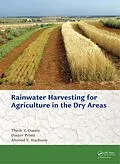Dry areas suffer not only from limited rainfall but alsonatural leakage'-90% of rainwater is lost directly or indirectly, and is unavailable for agriculture or domestic use. Water harvesting is a low-cost, easy-to-use, environmentally-friendly way to recover a large part of this lost water. How does water harvesting work? Which sites or areas are
Autorentext
T. Oweis is the director of the Integrated Water and Land Management Program (IWLMP) at the International Center for Agricultural Research in the Dry Areas (ICARDA) (CGIAR Future Harvest Center). He has carried out research into and published extensively on irrigation and water management since the 1980s, fulfilling numerous academic and institutional roles over time.
D. Prinz is an independent consultant in matters concerning irrigation, water management and harvesting, and water & soil conservation. During the course of his career, he has published and lectured extensively on many aspects of rural engineering, with a particular focus on water and land resources development; irrigation, water and soil conservation and water harvesting in agriculture.
A. Hachum is Professor in the Department of Water Resources Engineering, College of Engineering, Mosul University, Iraq and consultant for the Integrated Water and Land Management Program, ICARDA. He has published many articles as well as a number of monographs on the topics of irrigation and water harvesting.
Inhalt
1. Principles and practices of water harvesting 2. Hydrological aspects of water harvesting 3. Methods and techniques in water harvesting 4. Runoff inducement methods 5. Identification of areas suitable for water harvesting 6. Planning and design of water harvesting systems 7. Storage of harvested water 8. Implementation, operation, and maintenance of water harvesting systems 9. Socioeconomic issues 10. Water quality and environmental considerations
